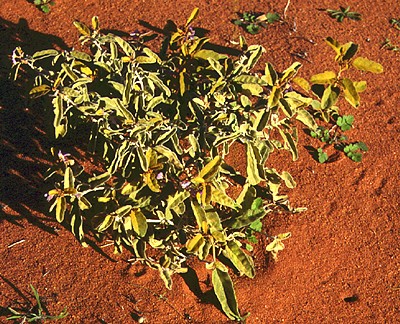
Synonymy
Solanum centrale J. Black, Trans. & Proc. Roy. Soc. S. Austral. 58: 180; t.11, fig. 4 (1934)
T: Macdonald Downs Stn, Central Australia, 1932, J. Chalmers s.n.; lecto: K; iso: AD; fide D.E. Symon, J. Adelaide Bot. Gard. 4: 167 (1981).
[S. nemophilum auct. non F. Muell.: J.M. Black, Trans. & Proc. Roy. Soc. S. Austral. 62: 106 (1938)]
Description
Clonal, perennial herb or undershrub to 45 cm, often sprawling, pale or rusty yellowish-green, densely pubescent with stellate hairs; prickles absent, or few and sparsely scattered on stems, 1–5 mm long.
Leaves ovate-oblong; lamina 3–6 cm long, 1–2 cm wide, sometimes larger, concolorous, entire to slightly undulate; petiole 5–15 (sometimes 30) mm long.
Inflorescence 1–6–flowered, peduncle absent or to 10 mm long; rachis 5–15 mm long, sometimes to 40 mm, pedicels 6–10 mm long. Calyx 4–6 mm long; lobes triangular, 1.5–2.5 mm long. Corolla stellate, 15–25 mm diam., pale or deep purple. Anthers 4.5–6.5 mm long.
Berry globular, 10–15 mm diam., yellow, drying brown and raisin-like in appearance. Seeds 2–4 mm long, pale yellow or light brown. n=24.
Distribution and ecology
Widespread in arid areas of W.A., N.T., south-western Qld and northern S.A. in sandy deserts.
Common name
Desert Raisin
Relationships
Considered by Bean (2004) to be a member of the S. macoorai group of subgen. Leptostemonum.
Notes
Important food plant of Aborigines; fruit eaten fresh or dry. This species is the most popular of the bush tucker foods and experimental work on its culture and diversity is taking place - see web references. The role of Solanum as Aboriginal food is comprehensively discussed in P. Latz, Bushfires & Bushtucker, IAD Press, Alice Springs (1995).
Information on the food composition of the fresh and dried fruit of S. centrale can be accessed through the NUTTAB 2006 (Nutrient Tables for use in Australia) database of the Food Standards Australia New Zealand.
Take care if you are contemplating eating the berries of a Solanum species - some of the many species are toxic and they can be easily confused with S. centrale.
Bean (2004) has added this species to the list of Solanum spp. occurring in Qld. There must be some doubt about his identification since the Qld material differs in characters documented for the ovary (stellate hairy according to Symon 1981, glabrous according to Bean); a glabrous ovary is one of the distinguishing characters Bean lists for recognising S. centrale from his newly described and closely related, S. jucundum .
Germination studies for mine regeneration or the native food industry indicated that germination of seed of this species is promoted with gibberellic acid, smoke water or the smoke isolate, karrikinolide.
Selected specimens
W.A.: SW of Warburton, A.S. George 4050 (PERTH). N.T.: Stirling Creek, Stuart Highway, N. Byrnes 187 (ADW, DNA); Hamilton Downs, 13 Apr. 1956, G.M. Chippendale (ADW, BRI, CANB, NT). S.A.: Ernabella, Aug 1945, J.B. Cleland (AD); Qld: Idalia NP, WSW of Blackall, along Emmet Pocket Rd, Sep. 1992, Bennie s.n. (BRI).
Plant status, if any
Conservation status as a plant of least concern in the
From the web
An Honours Thesis by Angela Dennet, Faculty of Agriculture, Food and Natural Resources University of Sydney entitled Underground structures and mycorrhizal associations of Solanum centrale (the Australian bush tomato) contains quite a lot of background material on this species. It can be downloaded at
Images of S. centrale on the Bean interactive key site can be accessed through the description at http://delta-intkey.com/solanum/www/centrale.htm while images on the Florabase site can be seen at http://florabase.calm.wa.gov.au/browse/photo?f=315&level=s&id=6995
Further information about the bush tomato can be found on government sites such as the Australian Native Foods site of CSIRO's Sustainable Ecosystems at www.cse.csiro.au/research/nativefoods/crops/bushtomatoes.htm or on bush tucker sites such as www.bushtuckershop.com/prod16.htm and http://www.outbackpride.com.au/species/desertraisin.asp
Concerns about the safety of bush foods for eating, including S. centrale, were addressed in a 2001 report by the Rural Industries Research and Development Corporation (RIRDC) entitled Food Safety of Australian Plant Bushfoods - it can be downloaded as a .pdf from www.rirdc.gov.au/pub/media_releases/24apr01.html




